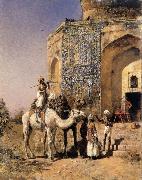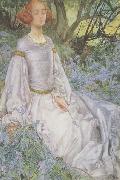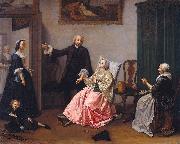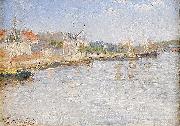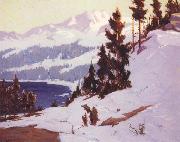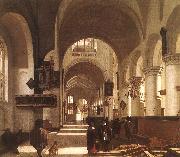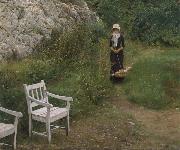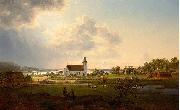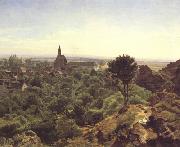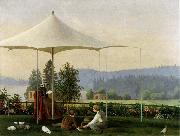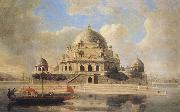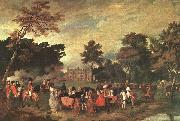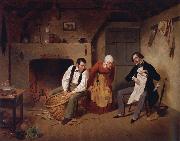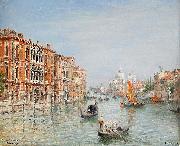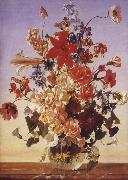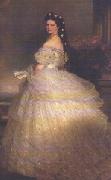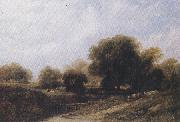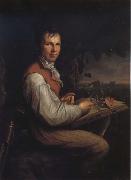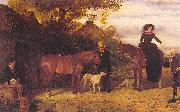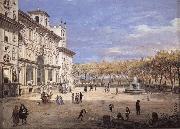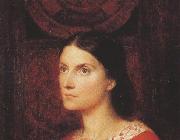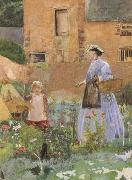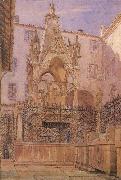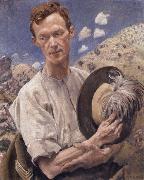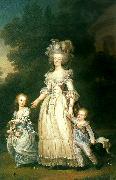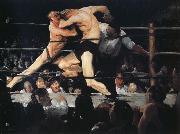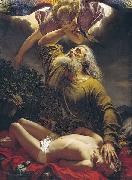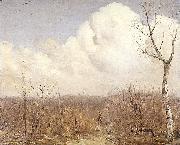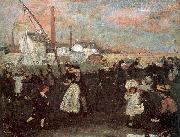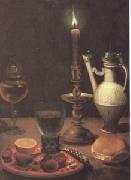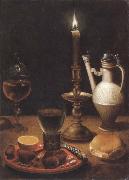|
|
|
|
|
|
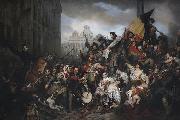 |
Egide Charles Gustave Wappers
|
|
(23 August 1803 Antwerp - 6 December 1874 Paris) is best known as the Belgian painter Gustave Wappers, while his oeuvre is also reckoned Flemish. He signed works by the name Gustaf Wappers.
He studied at the Royal Academy of Fine Arts in Antwerp, and during 1826 in Paris. The Romantic movement with its new ideas about art and politics was astir in France. Wappers was the first Belgian artist to take advantage of this state of affairs, and his first painting, "The Devotion of the Burgomaster of Leiden," appeared at the appropriate moment and had marvellous success in the Brussels Salon during 1830, the year of the Belgian Revolution. While political, this remarkable work revolutionized the direction of Flemish painters.
Episode of the Belgian Revolution of 1830 (1834), Museum of Ancient Art, Brussels.Wappers was invited to the court at Brussels, and was favoured with commissions. In 1832 the city of Antwerp appointed him Professor of Painting. He exhibited his masterpiece, "Episode of the Belgian Revolution of 1830" or rather "Episode of the September Days of 1830 on the Grand Place of Brussels", (Museum of Ancient Art, Brussels) at the Antwerp Salon in 1834. He was subsequently appointed painter to Leopold, King of the Belgians. At the death of Matthieu-Ignace Van Bree in 1839 he was elavated to director of the Antwerp Academy. One of his pupils was Ford Madox Brown; another was the Czech history painter Karel Javůrek.
His works are numerous; some of them in traditional devotional modes ("Christ Entombed"), while others illustrate the Romantic view of history: "Charles I taking leave of his Children", "Charles IX", "Camoens", "Peter the Great at Saardam", and "Boccaccio at the Court of Joanna of Naples".
Louis Philippe gave him a commission to paint a large painting for the gallery at Versailles, "The Defence of Rhodes by the Knights of St John of Jerusalem". He finished the work in 1844, the same year that he received the title of baron from Leopold I.After retiring as director of the Antwerp Academy, he settled in 1853 in Paris, where he died in 1873 - having been one of the most talented flagships of Romanticism in Belgium.
|
|
|
|
|
|
|
|
|
|
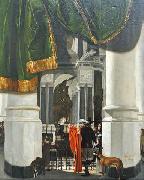 |
Emanuel de Witte
|
|
(1617 - 1692) was a Dutch perspective painter. In contrast to Pieter Jansz Saenredam, who emphasized architectural accuracy, De Witte was more concerned with the atmosphere of his interiors. Though few in number, de Witte also produced genre paintings.
De Witte was born in Alkmaar and learned geometry from his father, a schoolmaster. He joined the local Guild of St Luke in 1636. After a stay in Rotterdam, he moved to Delft and studied with Evert van Aelst. In 1651 de Witte settled in Amsterdam where his first wife, Geerje Arents, died in 1655. He then married a 23-year-old orphan, Lysbeth van der Plas, who exercised a bad influence on de Witte's adolescent daughter. In December 1659 both were arrested for theft from a neighbor.Lysbeth, pregnant, had to leave the city for a period of six years; she lived outside the city walls and died in 1663.
Following the arrest of his wife and child, de Witte was forced to indenture himself to the Amsterdam notary and art dealer Joris de Wijs, surrendering all of his work in exchange for room, board, and 800 guilders annually. De Witte broke the contract, was sued by the dealer, and forced to indenture himself further as a result. Several patrons provided de Witte with support, but these relations did not work out well, for he tended to shout at his clients and at people watching him at work in churches. Records tell of his gambling habit and a fight with Gerard de Lairesse. According to Arnold Houbraken, after an argument about the rent, de Witte hanged himself from a canal bridge in 1692. The rope broke and de Witte drowned. Because the canal froze that night, his corpse was not found until eleven weeks later
|
|
|
|
|
|
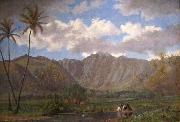 |
Enoch Wood Perry, Jr.
|
|
(1831-1915) was a painter from the United States.
Perry was born in Boston on July 31, 1831. His father was Enoch Wood Perry, and mother was Hannah Knapp Dole. His maternal grandparents were Samuel Dole and Katherine Wigglesworth. The family moved to New Orleans with his family as a teenager in 1848 and attended its public schools. After working several years as a clerk in a commission house, Perry began formal art education. In 1852 he went to Europe for four years and studied with Emanuel Leutze at the Desseldorf Academy, Thomas Couture in Paris, and in Rome.Perry served as the U.S. Consul to Venice between 1856 and 1858. Upon returning to America, he opened a studio in Philadelphia. |
|
|
|
|
|
|
|
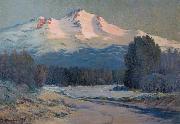 |
Ernst William Christmas
|
|
(1863-1918) was an Australian painter. He was born near Adelaide, South Australia in 1863 and studied art in Adelaide, Sydney and in London. He painted widely in England, exhibiting in the early years of the century at the Royal Academy, the Royal Institute of Oil Painters, the Royal Society of British Artists, the Royal Glasgow Institute of Fine Arts and in the provinces.
He was elected to the British Royal British Academy in 1909. In 1910-11, he painted mountains and lakes in Argentina and Chile. He lived in San Francisco around 1900 and again around 1915. He was an avid traveller, but spent the last two years of his life in Hawaii, where he painted landscapes including dramatic volcano scenes. Ernest William Christmas died in Honolulu in 1918.
|
|
|
|
|
|
|
|
Fiske Warren
|
|
Frederick Fiske Warren (2 July 1862-2 February 1938) was a hugely successful Paper Manufacturer, fine arts denizen and major supporter of Henry George's Single Tax system which he helped develop in Harvard, Massachusetts, United States in the 1930's. He was the son of Samuel Dennis Warren and Susan Cornelia Warren of Beacon Hill, Boston, Massachusetts and the brother to Samuel D. Warren (US attorney) and Edward Perry Warren.
Born in Waltham, Massachusetts, Fiske was raised in a mansion on 67 Mount Vernon Street[1] in Beacon Hill, Boston, Massachusetts. A philanthropic and highly educated family, the Warren brothers and sisters all enjoyed tranquil childhoods growing up between the family homes in Boston and Waltham, Massachusetts, also known as "Cedar Hill".
|
|
|
|
|
|
|
|
|
|
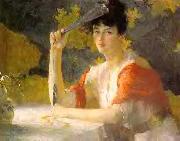 |
Frank Weston Benson
|
|
(March 24, 1862 - November 15, 1951) was an American Impressionist artist, and a member of the Ten American Painters.
Benson was born in Salem, Massachusetts. In 1879, he began study at the School of the Museum of Fine Arts, Boston under Otto Grundmann, and later at the Acad??mie Julian in Paris. Upon return to America, he would become an instructor at the School of the Museum of Fine Arts, Boston. Some of his best known paintings (Eleanor, Museum of Fine Arts, Boston; Summer, Rhode Island School of Design Museum) depict his daughters outdoors at Benson's summer home on the island of North Haven, Maine. He also produced numerous paintings and etchings of wildfowl.
Born into a successful merchant family, Benson lived in Salem for most of his life. At the Boston Museum school he befriended Edmund Charles Tarbell and Robert Reid, at the same time teaching drawing classes in Salem and painting landscapes during the summer. In 1883 he began his studies in Paris, and in the summer of 1884 painted at Concarneau, along with Willard Metcalf and Edward Simmons. His early paintings were conventional landscapes. |
|
|
|
|
|
|
|
|
|
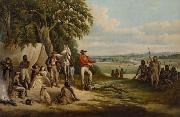 |
Frederick William Woodhouse
|
|
Frederick William Woodhouse
1820-1909
Woodhouse was born in Britain, but is better known as an Australian artist after his move to Australia. He painted images of Bush Life, and made many images from direct observation in sketchbooks and watercolors. He was also Australiaes most important horse racing painter, having painted every Melbourne Cup winner from 1861 until the introduction of the trackside camera. Although horses were his mainstay, Woodhouse also painted dogs, sheep, cattle, landscapes and portraits of persons. Between 1893 and 1894 he made a number of landscapes during a trip to Tasmania. |
|
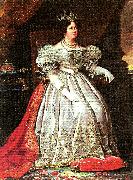 |
fredrik westin
|
|
Fredric Westin, född den 22 september 1782 i Stockholm, död 13 maj 1862 i Stockholm, historie- och porträttmålare.
Westin hade varit elev hos Lorens Pasch d.y. och Louis Masreliez på Konstakademien. Sedan han 1808 blivit kallad till akademiens agr?? och förordnad till konduktör vid kungliga museet blev han 1812 invald i Konstakademiens styrelse. Han blev 1815 vice professor och 1816 professor vid Konstakademien. Där var han också 1828-1840 direktör. 1843 utnämndes han till hovintendent.
Till hans tidigare skede och till hans främsta alster hör "Dagens stunder", fyra dörrstycken i Karl Johans sängkammare på Rosersbergs slott med antikiserande figurer: Aurora som strör blommor över jorden, Apollon med sitt fyrspann, Diana följd av Aftonrodnaden samt Natten med sitt stjärnströdda dok (1812-13). På Säfstaholms slott finns "De fyra årstiderna presiderade av jordens gudinna" (1843), på Rosendals slott "Hebe med örnen" (1832) och "Flora bekransande Linn??s byst" (1843) och vid Stockholms universitet "Musiken, föreställd av en grupp unga flickor". Han målade också kompositioner ur den svenska historien ("Olof Skötkonungs dop", "Lutherska lärans antagande").
Westin målade en stor mängd porträtt då han under Karl XIV Johans tid var konstnären på modet. Som porträttmålare var han dock inte enhälligt uppskattad. En kritiker som Silverstolpe beklagade 1809 att en konstnär som "äger så mycken färdighet till stöd för sitt sökande av idealet" sysselsatte sig med en konst av så lågt värde och hoppades att han "måtte återvända från den platta verkliga världen till den poetiska." Hammarsköld menade 1818 att av de svenska konstnärerna var det Westin som hade de ringaste anlagen för porträttmålning. Scholander kallade hans porträtt för "vaxgubbar". Andra hade lovord att fälla över Westins porträtt. Gerss ansåg att Westins porträtt hade likhet och behag i uttrycket, enkelhet i ställning och klädsel, urval av natur i formerna och säkerhet och sanning i utförandet. Wennberg kallade honom "den förste svenske tecknarens Lorenz Paschs så värdige fosterson".
Under Karl XIV Johans tid målade han rad porträtt på kungafamiljen. 1824 målade han en populär allegori över kronprinsessan Josefinas ankomst till Sverige, där Saga i gul och blå dräkt sitter på marken framför en runsten och blickar upp mot skyn där kronprinsessan i röd och vit dräkt svävar ned på en molntapp omgiven av tre amoriner. 1838 målade han Karl XIV Johan till häst på Ladugårdsgärdet hälsande med den trekantiga hatten.
Efter att Sandbergs altartavla för Sankt Jacobs kyrka hade underkänts vände sig de ansvariga till Westin med uppdraget att måla en altartavla. Målningen, "Kristi förklaring" var klar 1828 och resultatet blev både hyllat och kritiserat. Andra altartavlor av Westin finns i Kungsholms kyrka ("Kristi uppståndelse", 1825), Åbo domkyrka ("Kristi förklaring", 1836), Uddevalla kyrka ("Kristus välsignar barnen") samt Carl Gustafs kyrka ("Kristi begravning", 1832). |
|
|
|
|
|
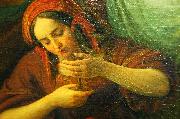 |
Friedrich Wilhelm Schadow
|
|
Friedrich Wilhelm Schadow (7 September 1789 - 19 March 1862) was a German Romantic painter.
He was born in Berlin and was the second son of the sculptor Johann Gottfried Schadow.
In 1806-1807 Friedrich served as a soldier. In 1810 he traveled with his elder brother Rudolph to Rome where he became one of the leaders among painters of the Nazarene movement. Following the example of Johann Friedrich Overbeck and others, he joined the Roman Catholic Church, and held that an artist must believe and live out the truths he essays to paint. The sequel showed that Schadow was qualified to shine more as a teacher and mentor than as a painter. As an author, he is best known for his lecture, Ueber den Einfluss des Christentums auf die bildende Kunst (About The Influence of Christianity On The Visual Arts) (Desseldorf, 1843), and the biographical sketches, Der moderne Vasari (Berlin, 1854).
In Rome, Schadow was given one of his first major commissions when the Prussian Consul-General, General Jakob Salomon Bartholdy, befriended the young painter, and asked him and three young compatriots (Cornelius, Overbeck and Veit) to decorate in fresco a room in his house on the Pincian Hill. The overall theme selected was the story of Joseph and his brethren, and two scenes, the Bloody Coat and Joseph in Prison, were conferred on Schadow. In 1819, Schadow was appointed professor in the prestigious Berlin Academy of the Arts, and his ability and thorough training gained many devoted disciples.
It was during this period that Schadow developed his paintings for churches. In 1826, Professor Schadow was made director of the Desseldorf Academy of the Arts, which he reoriented towards the production of Christian art, though he began a major dispute with one of its professors, Heinrich Christoph Kolbe, ending in the latter leaving the Academy in 1832. In 1837, Schadow selected, at request, those of his students best qualified to decorate the chapel of St Apollinaris on the Rhine with frescoes. When finished, they were acclaimed as the fullest and purest manifestation of the spiritual side of the Desseldorf school. One of his famous students, Heinrich Mucke, carried on the liturgical art with emphasis both in painting and frescoes. The painting of the "Wise and Foolish Virgins," considered one of his masterworks, was commissioned in 1842. Now in the Städel Museum, this large and important picture, while carefully considered and rendered, it however lacks power of some of his other works. |
|
|
|
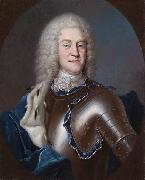 |
Georg Weissmann
|
|
painted Christian Ludwig II, Duke of Mecklenburg-Schwerin in 1731 |
|
|
|
|
|
|
|
|
|
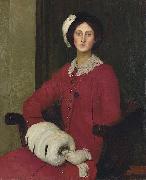 |
George Spencer Watson
|
|
R.O.I., R.P., A.R.A., R.A. (8 March 1869, London - 11 April 1934, London) was an English portrait artist of the late romantic school who sometimes worked in the style of the Italian Renaissance. He studied at the RA Schools from 1889, exhibited at the Royal Academy from 1891. He won Royal Academy Schools Silver Medals in 1889 and 1891, and the Landseer Scholarship in 1892. He was elected R.O.I. in 1900, R.P. in 1904, A.R.A. in 1923, and a Member of the Royal Academy (R.A.) in 1932.
He married Hilda, a dancer and mime artist, and follower of the actor Edward Gordon Craig. They had a daughter, Mary Spencer Watson (1913 - 2006), who became a sculptor. In 1923 he bought Dunshay Manor in the hills of the Isle of Purbeck, after already have spent holidays in Swanage.
He died in London and a memorial exhibition was held at the Fine Art Society in the same year. There is a memorial to him in the north vestibule of St James's Church, Piccadilly, London.
Some of his works are held at Tate Britain, the Harris Art Gallery, Preston and collections in Bournemouth, Liverpool, Plymouth and the National Gallery of Canada. Born in London, Watson studied at the Royal Academy from 1889; he exhibited there from 1891 and also at the Paris salon. Retrospective exhibitions were held at the Galerie Heinemann, Munich in 1912, and at the Fine Art Society in 1914. His work A Lady in Black (1922) is owned by the Tate Collection.
|
|
|
|
|
|
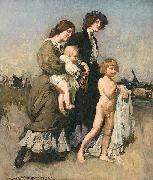 |
George Washington Lambert
|
|
(13 September 1873 - 29 May 1930) was an Australian artist, known principally for portrait paintings and as a war artist during the First World War.
Lambert was born in St Petersburg, Russia, the posthumous son of George Washington Lambert (1833 - 25 July 1873, in London) of Baltimore, Maryland. The younger Lambert's mother was Annie Matilda, nee Firth, an Englishwoman. Mother and son soon moved to Werttemberg, Germany, to be with Lambert's maternal grandfather. Lambert was educated at Kingston College, Yeovil, Somerset. The family, consisting of Lambert, his mother and three sisters, decided to emigrate to Australia. They arrived in Sydney aboard the Bengal on 20 January 1887. |
|
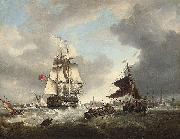 |
George Webster
|
|
Please search for George Webster (painter) in Wikipedia to check for alternative titles or spellings. |
|
|
|
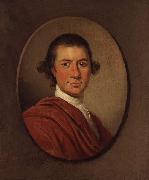 |
George Willison
|
|
Portrait painter who was born in Edinburgh in 1741 and returned there to spend his retirement.
He was a pupil of Mengs in Rome, before Mengs left for Madrid in 1761.
He painted "Boswell" in Rome in 1765 which is now in the Scottish National Portrait Gallery.
Willison was in London from 1767 and exhibited at the Scottish Academy between 1767 - 1770, and at the Royal Academy in 1771 and 1772.
He left London for an opulent retirement in Edinburgh around 1784.
|
|
|
|
|
|
|
|
|
|
|
|
|








